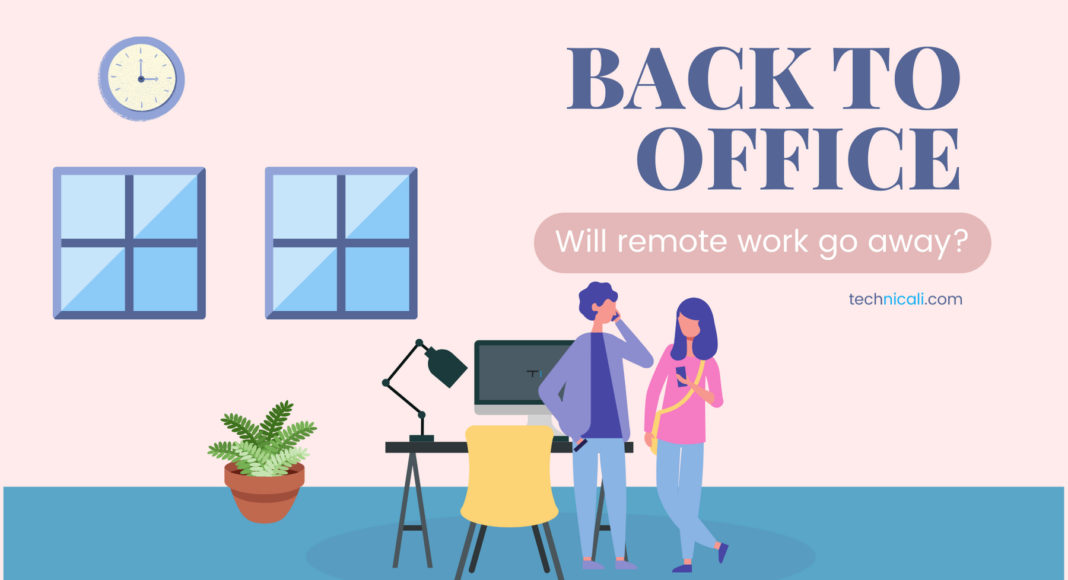Post pandemic lockdown forced all the employees to become remote workers and accept the hybrid working model. No one would have thought remote work could become a new way of working in a pre-pandemic situation.
Three years into the pandemic, everything has started to become usual with school opening up, vaccines coming out, and soon most companies will begin in full swing.
So the question many often ask is, will remote work go away with the office starting in full swing? Is this the end of the remote working era? The answer is no. Remote work is a reality that will prevail for a long, long time, even after 2022.
Contents
Is Remote Work here to stay?

According to Ladders, 25% of high-paying jobs in North America will be remote by the end of the year 2022. Further, there will be more remote jobs vacancies coming up in the year 2023.
Ladders, along with its portal, is also connected to other 50,000 plus employees providing remote working opportunities. More than 100k plus jobs have been listed on the ladders website alone. CEO of Ladder, Marc Cenedella, says remote working is not a fad. Remote work is here to stay. It is the future of work.
Only 4% of high-paying jobs were remote before the pandemic situation. This number had been extended to 9% near the end of 2020, rising to 15% in the current year. These numbers may be significant, but remote office job is more extensive than most people think. Remote working is not a big break that will go away after everything is normalized. Hybrid work and remote jobs are the foreseeable future of every industry.
Remote Work Struggles

Though studies have found various benefits of remote or hybrid work like increased productivity, healthy work-life balance, and improved health, hybrid schedules are a revolution in itself that needs time to adjust.
You can’t suddenly switch to remote working or go back to the office and hope to ensure the best results. It requires time and works on both the company’s and remote employees’ part.
Buffer’s State of Remote Work 2022 states the struggles hybrid workers face. Some of the most common challenges and solutions to remote working are as follows:
Unplugging after Work
Traditional in-person work has a set time limit. After the working hour, you are free to go home and leave the baggage of work stress itself. Working remotely, the employees sometimes forget to put an end time for the job and work for many hours.
There is no point in working endlessly and forgetting to switch off your professional time and switch back to personal time. Leaving the office indicates that the work is over and it’s time to go home for office workers. Remote workers are probably at the comfort of their home and have no such indicator signaling the end of their work time.
Solution
Schedule your work time and set the alarm for the end of your work hour. Make sure you set aside and make others know about the time they can contact you so that you are not disturbed in your non-work-related hours.
Also, make sure you tick off and complete all your to-do work within the allocated time of the workday. To complete the assigned work within the timeframe, setting realistic and achievable targets becomes essential.
Collaboration and Communication
19% of remote employees, according to Buffer, pointed to remote collaboration and communication as a more prominent problem in remote environments. When given a project in the office, you can easily talk to your colleagues and share project details, documents, paperwork, and other ideas.
The hybrid model of working sometimes restricts such collaboration and employee engagement. Lack of interactions with remote team members working from entirely different time zones possesses a real challenge and limitations in remote jobs.
Solution

Use technology to solve this limitation. The market today has been flooded with numerous collaboration and communication software. Remote workers need flexible, creative, responsive, and instant tools to enhance communication between employees. And remember, e-mail doesn’t count as a responsive and spontaneous communication channel. Use video conferences, live chats, virtual meetings, phone calls to increase collaboration.
Distractions

Distraction is the major productivity killer in a remote working environment. When you are working from home, you may hear your child crying his heart out for a toy, your wife scolding the child for making noise, or the TV’s sound that is too loud. Many more such reasons can easily distract you from your work. Sometimes scrolling your social media for a few minutes soon turns into an hour, and you realize you are now lacking in your career.
Solution
If you have space or an extra room, make a cozy office there and instruct everyone at home to keep their voices down when working. Ensure you close and lock the door to ensure no disturbance during your work hours. Those who have limitations of space can go to cafes near the house. Most cafes do provide wifi facilities hence ensuring your work completion.
Sometimes cafes also come with distractions, but they are a rare occurrence. To curb your digital distractions, put your phones in the other room. If that is not feasible, ensure you block your social media during your work hours. There are various tools available to block your social media and other apps.
Time Zone differences
Remote working allows the freedom to hire many talented employees from all over the world. However, this comes with a downside because all the remote workers operate in different time zones.
When one part of the world is working continuously, the other is sleeping peacefully and vice versa. This disturbs the team collaboration, and soon your remote team is out of sync. Also, you can’t force someone to work at night because that would only exhaust the employee and can lead to burnout in the long run.
Solution
Ensure you have a concrete guideline in place that clearly states the responsibilities of each employee. While working every night is not possible, keeping an hour for a meeting every week is feasible for all employees. Ensure you set the date and time by considering all the remote employee’s wishes. Use this time to conduct meetings, track project progress, establish future guidelines, and discuss new ideas.
Motivation and productivity
Motivation and productivity are two significant barriers to remote working. With the lack of supervisors or managers peeping their heads into your work, remote workers tend to take their work leniently.

Further, loneliness in work is a significant factor that kills motivation and productivity. If you are a person that needs constant supervision to ensure your work completion, then remote working is going to tear you apart and dampen your productivity.
Solution
To increase your productivity, the first thing you should do is avoid multitasking, as it reduces productivity by 40%. The next thing you should do is eliminate all the possible distractions. Lastly, it would help if you took short 10 minute breaks after constant work of an hour or two to re-energize and better concentrate on your work.
If you are losing motivation, which is a common phenomenon in remote working, talk to your seniors or leaders to look into the problem. Don’t be shy. Speak out. Maybe many of your colleagues face the same problem.
Further, while working remotely, make a point to compete with yourself rather than your colleagues to enhance your motivation. If a task needed 2 hours for completion yesterday, ensure you complete the task in less time today.
Advantages of Working Remotely
While the limitations of remote working may seem challenging, the solutions to remedy the situation are very simple if you apply them. Further, the advantages of remote working quickly make up for the limitations of the remote environment.

Some advantages of remote work are as follows:
Commutation expenses
To get a well-paid job, a person often moves to metro cities. He has to travel long hours to get to and fro from his office. One in every four employees quit their jobs due to long traveling distances. Further, the fuel burned by the car, bus, or train is around $4523.04 per year, along with 408 hours of free time that goes into commuting.
This causes severe effects on employer expenses and employee’s time. Remote workers only have to get to their laptops or nearest cafe which comparatively is very inexpensive. Additionally, remote employees get extra hours in their hands dedicated to their family, exercise, and other activities. This plays an upper hand.
Work-life Balance
One of the most preferred reasons an employee would choose remote working is to better structure and balance their life. Employees have to work 8 hours plus the 2 hours (average) commutation time needed to travel back and forth in the office.

After such an exhaustive day, the employee has no energy or time for their family. They choose to relax in the comfort of their homes. A chunk of commutation time is saved in remote work, and the traveling exhaustion is missing, which gives remote workers energy and time to spend with their loved ones.
Employee Productivity
Remote employees work an average of 21.9 days every month which is 1.4 more days than an office worker who works 20.5 days. Remote workers are dedicated to their work and get things done during their additional working hours.
Further, many studies have pointed out that remote working employees spend 27 minutes doing unproductive activities per month. In comparison, office workers spend 37 minutes doing unproductive activities outside their standard breaks.
Employee health
Working remotely saves more than 408 hours traveling to and fro to the office. Employees can use this time to concentrate on their health by taking a gym membership or simply going out for the run.
Further, fully remote employees enjoy the luxury of eating home-cooked meals, which relatively cut out the junk food intake that person may consume during the office breaks. Recently, when there is a rise in employee burnout and stress, eating the right food and exercising have become crucial.
Hybrid as a Permanent Solution to Remote Workers
Traditionally remote working was seen as a privilege. Today, it is considered the new normal of the industry. Remote jobs have made it possible for an employee to work from anywhere in the world. Employees working in the office needed to move to tier 1 cities where living could be costly. Remote working offers greater flexibility for many employers to bring in talent to their workplace.

Remote working has opened doors to higher income and saving opportunities. Teams in remote settings are working from tier 2 and tier 3 cities. This has led the small villages and towns to flourish and grow, leading to the economic development of the entire country.
Most companies have accepted the revolutionary change of remote working and have permanently shifted to a hybrid model as their company culture. These businesses have seen the true power and productivity of remote jobs. Both Employers and Employees are also saving a lot of their revenue in offices rent, amenities, traveling, and light expenses.
In contrast, some companies are still claiming and waiting for normalcy to return, ignoring the blatant fact that things are never going back to the office as to how it was pre-pandemic. Whether it is Ukraine-Russia Conflict or Covid Pandemic; It has now shaped a new, exciting, profitable, and more comfortable way of working.
Companies ignoring the true potential of remote working environments will face the consequences in the form of employee resignations, a decline in clients, and loss of business. A survey of the Human Workplace Index stated that 56% of employees would be willing to quit their jobs if required changes are not done within a month or two.
Conclusion
The historical shift after covid-19 in working from office to home has been very abrupt and challenging. Though remote working struggles are challenging, the benefits easily overpower them. Companies and employees waiting to return to the office need to understand that remote work is not a big break. The hybrid model of work is here, and it will stay for a long time. Remote work is a new lifestyle decentralizing workforce control. Experts have estimated that above 70% of the workforce will work remotely by 2025.

